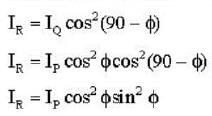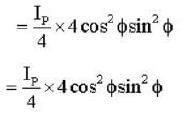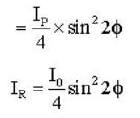GATE Exam > GATE Questions > Three polarisers P,Q and R are placed paralle...
Start Learning for Free
Three polarisers P,Q and R are placed parallel to each with their planes perpendicular to the z-axis. Q is placed between P and R Initially, the polarising directions of P and Q are parallel but that of R is perpendicular to them . In this arrangement when unpolarised light of density l0 is incident on P , the R intensity coming out of R is zero, the polariser Q is now rotated about the z-axis. The maximum intensity of light coming out of R is
- a)I0
- b)

- c)

- d)

Correct answer is option 'D'. Can you explain this answer?
| FREE This question is part of | Download PDF Attempt this Test |
Verified Answer
Three polarisers P,Q and R are placed parallel to each with their plan...
Consider three polarisers P,Q and R Initially, polarising direction of P and Q are parallel but that of R is perpendicular to them.
Intensity of light passing through P is

Intensity of light passing through Q , according to law of malus IQ = Ipcos2 φ) Intensity of light coming out of R is



sin2 φ = l( IR will be maximum , when φ= π/4)

Intensity of light passing through P is

Intensity of light passing through Q , according to law of malus IQ = Ipcos2 φ) Intensity of light coming out of R is



sin2 φ = l( IR will be maximum , when φ= π/4)


|
Explore Courses for GATE exam
|

|
Similar GATE Doubts
Three polarisers P,Q and R are placed parallel to each with their planes perpendicular to the z-axis. Q is placed between P and R Initially, the polarising directions of P and Q are parallel but that of R is perpendicular to them . In this arrangement when unpolarised light of density l0 is incident on P , the R intensity coming out of R is zero, the polariser Q is now rotated about the z-axis. The maximum intensity of light coming out of R isa)I0b)c)d)Correct answer is option 'D'. Can you explain this answer?
Question Description
Three polarisers P,Q and R are placed parallel to each with their planes perpendicular to the z-axis. Q is placed between P and R Initially, the polarising directions of P and Q are parallel but that of R is perpendicular to them . In this arrangement when unpolarised light of density l0 is incident on P , the R intensity coming out of R is zero, the polariser Q is now rotated about the z-axis. The maximum intensity of light coming out of R isa)I0b)c)d)Correct answer is option 'D'. Can you explain this answer? for GATE 2024 is part of GATE preparation. The Question and answers have been prepared according to the GATE exam syllabus. Information about Three polarisers P,Q and R are placed parallel to each with their planes perpendicular to the z-axis. Q is placed between P and R Initially, the polarising directions of P and Q are parallel but that of R is perpendicular to them . In this arrangement when unpolarised light of density l0 is incident on P , the R intensity coming out of R is zero, the polariser Q is now rotated about the z-axis. The maximum intensity of light coming out of R isa)I0b)c)d)Correct answer is option 'D'. Can you explain this answer? covers all topics & solutions for GATE 2024 Exam. Find important definitions, questions, meanings, examples, exercises and tests below for Three polarisers P,Q and R are placed parallel to each with their planes perpendicular to the z-axis. Q is placed between P and R Initially, the polarising directions of P and Q are parallel but that of R is perpendicular to them . In this arrangement when unpolarised light of density l0 is incident on P , the R intensity coming out of R is zero, the polariser Q is now rotated about the z-axis. The maximum intensity of light coming out of R isa)I0b)c)d)Correct answer is option 'D'. Can you explain this answer?.
Three polarisers P,Q and R are placed parallel to each with their planes perpendicular to the z-axis. Q is placed between P and R Initially, the polarising directions of P and Q are parallel but that of R is perpendicular to them . In this arrangement when unpolarised light of density l0 is incident on P , the R intensity coming out of R is zero, the polariser Q is now rotated about the z-axis. The maximum intensity of light coming out of R isa)I0b)c)d)Correct answer is option 'D'. Can you explain this answer? for GATE 2024 is part of GATE preparation. The Question and answers have been prepared according to the GATE exam syllabus. Information about Three polarisers P,Q and R are placed parallel to each with their planes perpendicular to the z-axis. Q is placed between P and R Initially, the polarising directions of P and Q are parallel but that of R is perpendicular to them . In this arrangement when unpolarised light of density l0 is incident on P , the R intensity coming out of R is zero, the polariser Q is now rotated about the z-axis. The maximum intensity of light coming out of R isa)I0b)c)d)Correct answer is option 'D'. Can you explain this answer? covers all topics & solutions for GATE 2024 Exam. Find important definitions, questions, meanings, examples, exercises and tests below for Three polarisers P,Q and R are placed parallel to each with their planes perpendicular to the z-axis. Q is placed between P and R Initially, the polarising directions of P and Q are parallel but that of R is perpendicular to them . In this arrangement when unpolarised light of density l0 is incident on P , the R intensity coming out of R is zero, the polariser Q is now rotated about the z-axis. The maximum intensity of light coming out of R isa)I0b)c)d)Correct answer is option 'D'. Can you explain this answer?.
Solutions for Three polarisers P,Q and R are placed parallel to each with their planes perpendicular to the z-axis. Q is placed between P and R Initially, the polarising directions of P and Q are parallel but that of R is perpendicular to them . In this arrangement when unpolarised light of density l0 is incident on P , the R intensity coming out of R is zero, the polariser Q is now rotated about the z-axis. The maximum intensity of light coming out of R isa)I0b)c)d)Correct answer is option 'D'. Can you explain this answer? in English & in Hindi are available as part of our courses for GATE.
Download more important topics, notes, lectures and mock test series for GATE Exam by signing up for free.
Here you can find the meaning of Three polarisers P,Q and R are placed parallel to each with their planes perpendicular to the z-axis. Q is placed between P and R Initially, the polarising directions of P and Q are parallel but that of R is perpendicular to them . In this arrangement when unpolarised light of density l0 is incident on P , the R intensity coming out of R is zero, the polariser Q is now rotated about the z-axis. The maximum intensity of light coming out of R isa)I0b)c)d)Correct answer is option 'D'. Can you explain this answer? defined & explained in the simplest way possible. Besides giving the explanation of
Three polarisers P,Q and R are placed parallel to each with their planes perpendicular to the z-axis. Q is placed between P and R Initially, the polarising directions of P and Q are parallel but that of R is perpendicular to them . In this arrangement when unpolarised light of density l0 is incident on P , the R intensity coming out of R is zero, the polariser Q is now rotated about the z-axis. The maximum intensity of light coming out of R isa)I0b)c)d)Correct answer is option 'D'. Can you explain this answer?, a detailed solution for Three polarisers P,Q and R are placed parallel to each with their planes perpendicular to the z-axis. Q is placed between P and R Initially, the polarising directions of P and Q are parallel but that of R is perpendicular to them . In this arrangement when unpolarised light of density l0 is incident on P , the R intensity coming out of R is zero, the polariser Q is now rotated about the z-axis. The maximum intensity of light coming out of R isa)I0b)c)d)Correct answer is option 'D'. Can you explain this answer? has been provided alongside types of Three polarisers P,Q and R are placed parallel to each with their planes perpendicular to the z-axis. Q is placed between P and R Initially, the polarising directions of P and Q are parallel but that of R is perpendicular to them . In this arrangement when unpolarised light of density l0 is incident on P , the R intensity coming out of R is zero, the polariser Q is now rotated about the z-axis. The maximum intensity of light coming out of R isa)I0b)c)d)Correct answer is option 'D'. Can you explain this answer? theory, EduRev gives you an
ample number of questions to practice Three polarisers P,Q and R are placed parallel to each with their planes perpendicular to the z-axis. Q is placed between P and R Initially, the polarising directions of P and Q are parallel but that of R is perpendicular to them . In this arrangement when unpolarised light of density l0 is incident on P , the R intensity coming out of R is zero, the polariser Q is now rotated about the z-axis. The maximum intensity of light coming out of R isa)I0b)c)d)Correct answer is option 'D'. Can you explain this answer? tests, examples and also practice GATE tests.

|
Explore Courses for GATE exam
|

|
Suggested Free Tests
Signup for Free!
Signup to see your scores go up within 7 days! Learn & Practice with 1000+ FREE Notes, Videos & Tests.


















